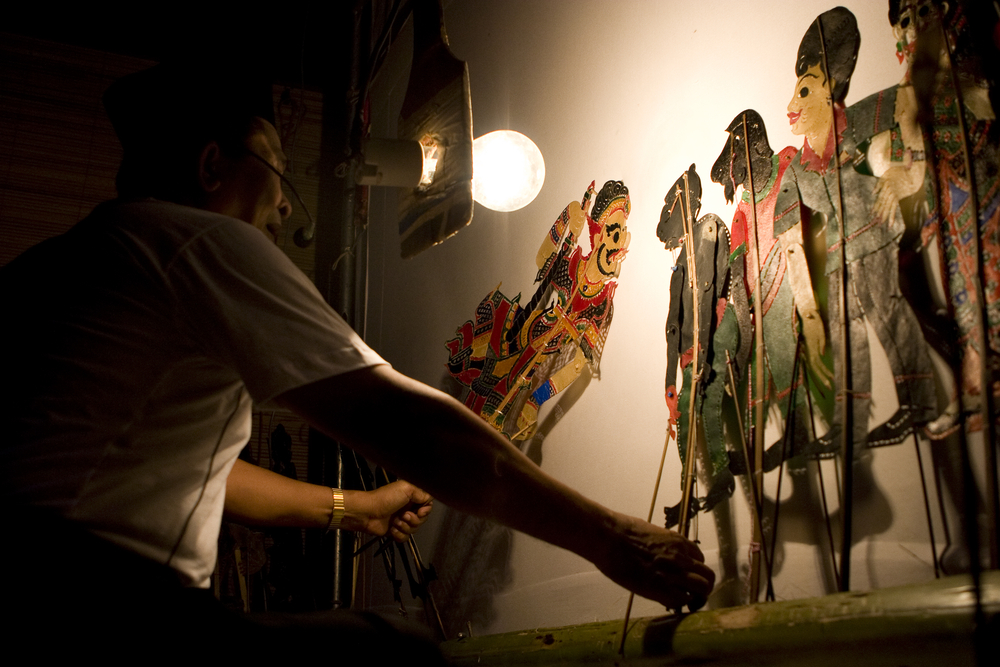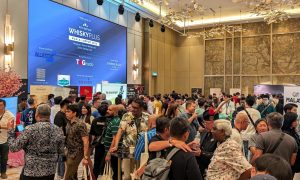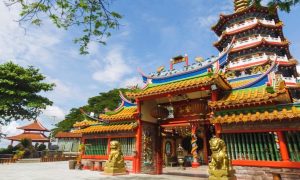
The Mahabharata and Ramayana are two ancient Sanskrit epics. Shadow puppet performances usually portray stories from these epics. “Hikayat Seri Rama” is the literary adaptation of the Ramayana in Malaysia. The story remains the same as the original epic, but some aspects were modified to have a more local context. The shadow puppet theatre adaptation of the Ramayana in Malaysia is known as Hikayat Maharaja Wana and is considered one of the most important shadow plays.
Shadow puppets are known as wayang kulit in Malaysia. Wayang and kulit translate to “puppet” and “skin,” respectively. (Traditionally, these puppets are made from water buffalo skin.) Puppets are decorated with cutouts, paint, and gold leaf. Every wayang kulit character also has adornments such as crowns, necklaces, bracelets, anklets, earrings, and so on. The ornamentation of each puppet conveys information: various crowns reflect varying social statuses. Likewise, every puppet’s stature reflects it’s disposition: a bowed head reflects a calm nature and a head position that is looking upward is an ambitious personality.
Here are a few things to note about shadow puppet performances in Malaysia:
Shadow puppet traditions are found in a number of Southeast Asian countries. In Malaysia, the Wayang Kulit Kelantan is influenced by both Indonesia and nearby Thailand; hence, shadow puppets are also know as known as Wayang Kulit Siam in Kelantan.
It is a disappearing traditional art form, with less than 10 practicing dalangs remaining in Malaysia. Organizations such as Pusaka are trying to preserve and revitalize this performance style. Traditionally, the dalang would go into a trance prior to performance and would have the ability to use different voices for each character.
The audience and the performance are protected by incantations recited by the dalang prior to the start of the performance while spreading rice and placing a kris in front of the stage.
Each gamelan piece has a distinct sound and is used for particular purposes throughout the performance. The names of the instruments are: serunai (oboe), gedumbak (pot drums), geduk (stick drums), canang (small gongs), gendang (double headed drums), kisi (cymbals), and the tetawak (hanging gongs).
Elements of the Malaysian version of the traditional epic Ramayana vary from the versions known in other countries such as Indonesia and India – for example, according to the Malay version, the monkey god Hanuman is the son of Rama, not just his ardent devotee as he is portrayed in the Hindu texts of the Ramayana. Character names also vary; for example, Sita is also known as Siti Dewi.
In shadow puppet theater, the puppets, dalang (puppeteer) and gamelan musicians are located behind a screen. While wayang kulit characters are beautifully crafted, the audience only sees the shadows of each one as they are manipulated by the dalang. As fascinating as it is to watch the shadows and follow the story, it is just as interesting to watch the performance as it goes on behind the screen. Performances can occur for a variety of reasons: to entertain, educate, and/or commemorate a special occasion. References to current events, pop-culture and even politics are added to performances. Modern day performances are abbreviated versions; traditionally performances lasted throughout the night.
Wayang kulit theatre can be seen in Kelantan, but performances are rarely seen in Kuala Lumpur. In April 2014, a shadow puppet performance took place at the Muzium Seni Asia on the Universiti Malaya campus. It was arranged in conjunction with The Malaysian Culture Group. The dalang was Dato’ Prof. Dr. Hashim Yaacob, probably the only English-speaking dalang in Malaysia. He arranged for a gamelan troupe to come from Kelantan for the event. The dalang chose to perform “The Abduction of Sita by Rawana”, a classic story from the Ramayana. Here is a brief summary of the story: the main characters are Rama, Sita, Hanuman, Rawana, and Jentayu. Rama and Sita are married; Rawana wants Sita for himself and kidnaps her. Jentayu tries to help Rama get Sita back. Rawana fights with and wounds Jentayu. Hanuman steps in to help Rama fight Rawana. Hanuman and Rama eventually win the battle and Sita is reunited with Rama.
The Muzium Seni Asia is fortunate enough to have a collection of shadow puppets, including some from the highly respected Tok Dalang Dollah Baju Merah. They are not on permanent exhibition, but some were on display during the shadow puppet performance. The puppet collection is in the process of being professionally photographed and a book on these puppets is under discussion. This is an important step in the conservation and documentation of these puppets.
Written by Dawn Babcock.
Read more:




















